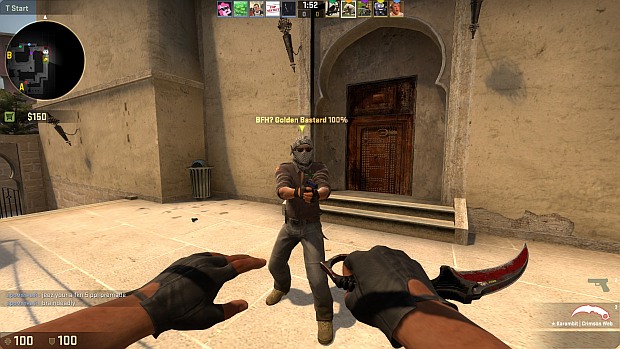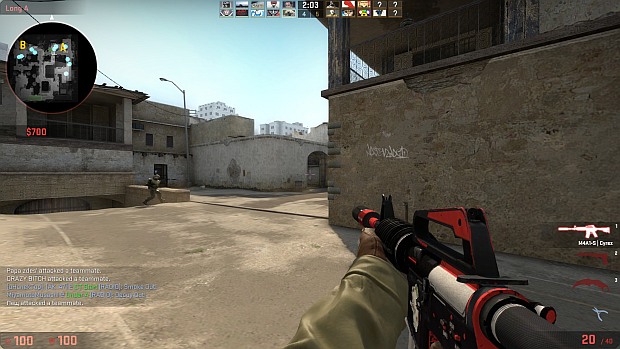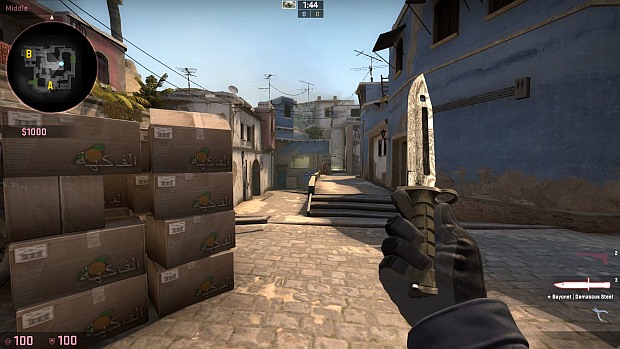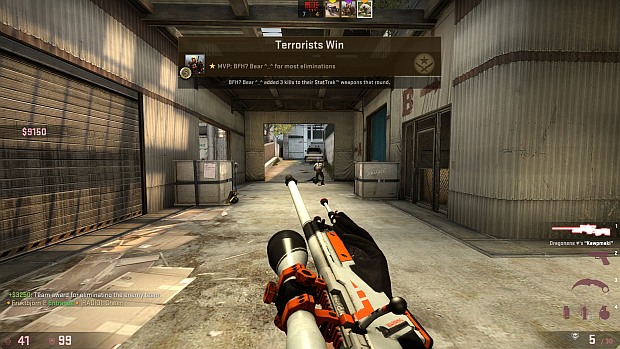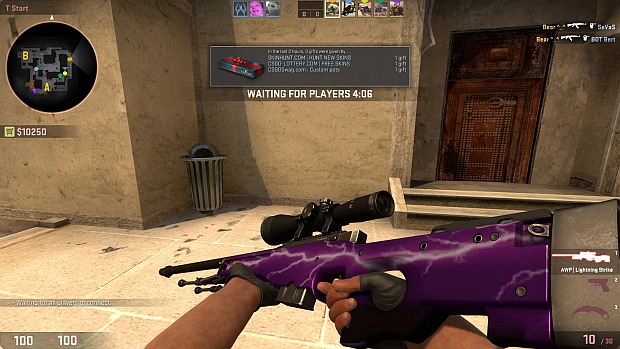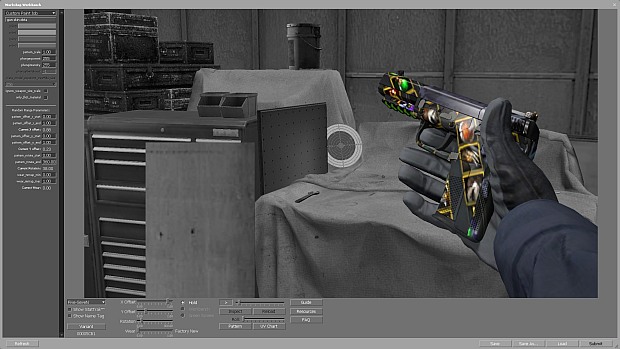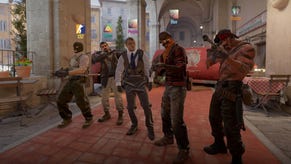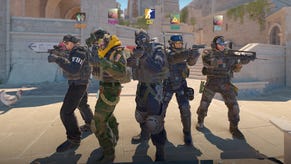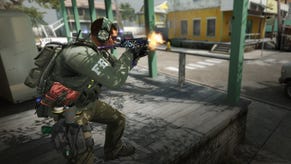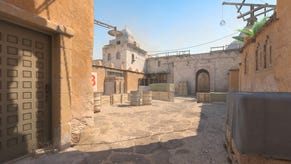How Counter-Strike: Global Offensive's Economy Works
Pop Flash
In Pop Flash, a series of insights into Counter-Strike: Global Offensive [official site], Emily Richardson looks past the amazing clutches and crushing defeats to understand the culture and meta of Valve’s everlasting competitive FPS.
Counter-Strike’s weapon skins are as numerous as they are glamorous. The very best in tactical fashion, they’re bright, they’re weird, they’re occasionally very expensive. Some of us don’t care for them, but many more do. They’ve been a phenomenal success, so much so that the rarest knives sell for more than the Steam wallet’s cap of $500, and betting and trading sites are springing up all over the web.
I’m gonna be straight with you now; I love the weapon skins. I wish I didn’t - I’ve spent more money than I’d like on stupid digital keys for stupid digital boxes. Some people know the CSGO economy and play it well. They make money on rare knives, withhold crates until they’re discontinued and spike in price… they know what they’re doing, basically. Me? I’m not one of those people. I just want a very pink, very ‘80s-disco’ style Karambit Fade so I can look cool. Or rather, so I can imagine I look cool.
Counter-Strike’s cosmetic economy is an intriguing thing. A week ago, I opened a case and it dropped a knife. My first thought was that I could trade it up with my old knife and get an improvement. I’m always wanting to get something better, something rarer. Why?
A while back I saw a fantastic talk by Bronwen Grimes, a technical artist at Valve. In it, she discusses how the small CSGO team implemented the item economy with weapon skins. She spoke in depth about how players value items and what Valve learned during the process. The first half is mostly a technical dissection of how they made the skins but the second half is about player value and how the economy’s shaped itself. It even details what they considered for customisation before weapon skins.
For example, the team looked at player model customisation, entirely new weapons and cosmetic mesh changes for existing weapons (so, being able to reshape the gun barrel, or the grip or the butt, etc.). They ruled out each of these. In Dota 2, you can always see your hero, so having a customisable character model makes sense - you get to appreciate it. But for Counter-Strike, only other players get to view your character and the team found that lots of changes to the models caused confusion. There were visibility problems and team-identification problems. The more skins were made, the more severe the problem would get. Entirely new weapons would cause major balance issues and push veteran CS players away from the format that they loved. And though the team got quite far with the weapon mesh changes, they realised that the silhouettes became confusing and hard to identify. Weapon skins, however, seemed promising.
We know now which weapon skins sell for astronomical prices and which don’t. We tend to like the same items, the ones that are flashy and colourful, and thus we drive the prices of these cosmetics up. But that’s not what Valve initially predicted.
In the beginning, Grimes’ team worked on recreating hydrographic camouflages because they’re fairly easy to do as a starter skin, and they imagined the CSGO community would value realistic-looking weapons more than, well, tacky-looking ones. I don’t use the word ‘tacky’ to be mean - I’m the proud owner of a Blood in the Water scout, so y’know. Tacky, in this context, works. And that’s what Valve realised.
Grimes goes on to describe how the team studied a vast array of source material, hoping to make realistic gun skins, like camouflage paints. Looking at the nitty-gritty details, they realised that there were loads of different ways to style a weapon.
Then came the revelation. As Grimes puts it, “In the course of gathering reference we discovered that… in the real world, people make things we found unattractive.”
She continues, “it begs the question, what do our customers want? The game’s art style is grounded in the real world and we’ve already gone down the road of replicating real-world finishing techniques. But there’s a really broad range of service providers in the real world catering to a broad range of tastes. In our game world, we’re the only suppliers and our taste might not match demand. So we needed to focus less on what we personally liked and more on creating a broad range of variety in order to measure people’s reactions.”
And that’s what they did. The first Arms Deal release featured an incredibly varied array of skins - from the deep green of DDPAT camos to the ridiculousness of the AWP Lightning Strike (a personal favourite). Grimes says that, if you only have one skin for a weapon, nine times out of ten you’ll equip that skin. However, some skins are disliked so much that people would rather use the default black weapon. These skins, Grimes notes, are all camouflage skins that look like the original hydrographic inspiration.
“So although we started off thinking military camouflage was really cool…” she says, “it turns out what our community really values are finishes that look more like paintball guns.
“We needed a reminder that although Counter-Strike is military inspired, it’s not a military simulation. It’s a sport. When our customers play, they don’t aspire to be soldiers, they aspire to be elite Counter-Strike players. So maybe it’s not that surprising that the closest real-world analogue we’ve got to our preferred aesthetic comes from a sport.”
This is a sentiment that, when asked, economy specialist and online marketplace researcher Dr Vili Lehdonvirta agrees with. “I used to play CS and I know that it's a very competitive game,” he says. “I also used to play paintball, which is likewise competitive. Many paintball players spend a lot of money on cool looking gear, and nobody thinks that's at all odd or inconsistent with the competitive nature of the game. Google some professional paintballers - those people look like peacocks compared to CS avatars. The same goes for cycling, sailing, motorsports, etc. Esports still have ways to go in this area.”
“If you looked at our content,” Grimes says in her talk, “you’d assume that we understood this from the start and decided to put the bright, visually salient items into the top of our quality tiers because we knew they had high value. But actually it was a risk-mitigation strategy. We were genuinely worried that people wouldn’t like the bright items. So instead of thinking of these as being sorted by value, we originally sorted them by risk. If you got an item from the top tier, you’d be happy because it was rare, even if you didn’t like the look. And other customers would be happy because they didn’t have to see bright items very often, since there were so few of them.”
So, why are some items so expensive they’re sold on external sites, away from the Steam wallet cap? Well, Vili thinks that people value items in games just like they value things in real life, and I’m inclined to agree. Logic would argue that a skin does nothing to benefit you, but there’s the same feeling of satisfaction involved that comes with obtaining something nice in the real world. And hey, a lot of real-world items don’t benefit you either. Consider how rare a knife is in CSGO, and then how rare some knives are compared to other knives. If you get one of those spectacularly rare ones, you have something valuable and unique that very few other players have. Not only that, but each skin is generated with a wear quality and even a unique orientation or pattern to the skin. This is where you see people on trading sites citing that their knife is “70% purple, 20% pink, 10% yellow”, has “great webs” or “looks factory new”. How each individual skin fares when compared to its siblings has a profound effect on its worth, creating a greater value disparity between weapons with the same sought-after skin. And this is something that happens across all economies.
Valve explicitly state that the best way to develop a flourishing economy is to have lots of different factors making a single item more or less desirable. For CSGO, these factors include rarity, aesthetics, wear quality, pattern orientation and whether the gun is StatTrak. Even novelty and nostalgia play into how players value a gun. Perhaps most important, though, is the weapon itself. Skins for the AK, M4s and AWP are most valuable because they’re shown on high utility weapons. This all contributes to an economy that fluctuates as different players value different qualities within a single item.
Meanwhile, other expectations were quashed, too. The CSGO team underestimated how many weapon cases players were going open and as a result the different quality and rarity tiers were thrown slightly off-kilter. For example, the Red Laminate and the Black Laminate AK-47 skins. The Red one drops from a case, the Black drops in-game.“The Red is two quality tiers above the Black,” Grimes explains. “Aesthetically speaking they’re very similar. If anything, the Red Laminate is more striking, making that two ways in which we would have expected the Red to have a higher value. But due to the volume of cases opened, there are actually more Red Laminates in the world than Black ones. The Red Laminate AK-47, which we expected to have a high value, is consistently around four dollars cheaper [at the time of this talk] than the Black. Exacerbating the effect is that the Red Laminate is listed at a higher proportion relative to the total number of them in the world. If you own a Red Laminate, you’re twice as likely to list it on the marketplace as the Black. Scarcity’s influence on price is pretty extreme. It’s one of the clearest predictors of value that we’ve got.”
It’s this valuable scarcity we’re all hoping for when we open a case in CS. “The crate and key mechanism of distributing loot is just basic gambling psychology,” says Vili. “A variable-rate reinforcement schedule, a slot machine. To my knowledge, it first appeared in a Chinese MMO ZT Online in 2006 or 2007. Today, it's of course used in a wide variety of games as a tacit way of introducing a revenue-generating slot machine into the game that's at least slightly integrated with the core gameplay. But as a developer you have to be mindful of gambling laws if it becomes possible to convert the winnings into real money.”
I’m not the type of person to enjoy a casino or slot machine. The idea of gambling money in a casino-style environment doesn’t appeal to me at all, in fact. But I do regularly throw money at CSGO’s crates. £1.69 for a key doesn’t seem very much, when you’re buying them one at a time. Besides, there’s always the chance you’ll get a knife and make your money back, right? Well, I’m not sure. I had a friend who played CSGO for just a couple of weeks and one of her very first crates dropped her that ever-desirable, perfectly curled Karambit Fade knife. Most of us aren’t that ridiculously lucky, though. If you’re anything like me, you’re probably just avoiding the ‘money spent’ statistic altogether.
So I have to wonder, could the cases be particularly bad for people who are more likely to form a gambling addiction? Lars Olson, a neuroscientist at Karolinska Institutet, gave me his thoughts on the subject.
“Some people are more susceptible to any and all forms of addiction,” he says, “be it alcohol, drugs, or behaviours, than others. This is because we’re genetically different, and in some the genes of importance for the reward system in the brain are such that the reward system becomes more easily "kidnapped" by rewarding experiences such as gambling. […] The problem is when we are exposed to drugs or behaviours that are even more pleasant than natural pleasures, because then the reward system rebuilds itself so we will want that even stronger pleasure more than the naturally available ones.”
He hasn’t played Counter-Strike, so I do my best to explain the crate and key system before asking if the relatively low set key price would have any effect on luring more susceptible people in. “It is of course more tempting if the keys are cheap in relation to the value of the items you find,” he says. “It seems you can ‘win' something that is about 200 times more valuable than the price you pay. This, on the other hand, is less than in some lotteries. How addictive it might be has to do with many things, such as how fast the reward comes after your payment. The shorter the time between action and reward, the more addictive. Also, if the reward is coupled to additional sensations, such as sound or visual events. And how often there are rewards. This has been well studied scientifically for slot machines.”
It gives us something to think about. Personally, I find the current system enjoyable and fun within the context of the game and I can totally stop any time I like. Honest. With regard to external betting sites, like CSGO Lounge and CSGO Jackpot, I’m not sure whether they’re better or worse. On the one hand, you’re betting with weapon skins and not real money, but on the other, some of those skins are worth a lot. I got my first knife by betting four dropped Dreamhack Winter 2013 cases on the grand final between NIP and Fnatic and winning around £50 worth of skins. I traded the majority of them directly into a Gut Knife Night called Slippy. Where Slippy is now, I have no idea. Probably several players further along the trade route to obscurity and inevitable oblivion. After all, there will come a day when none of these skins are worth a dime.

